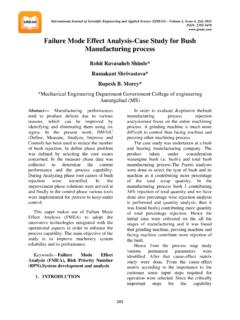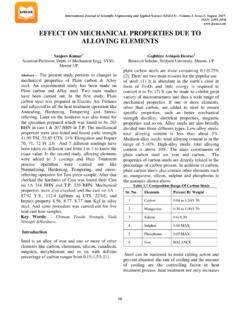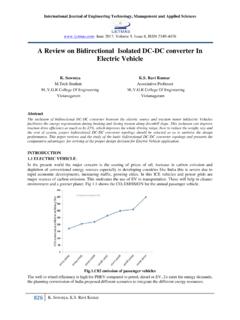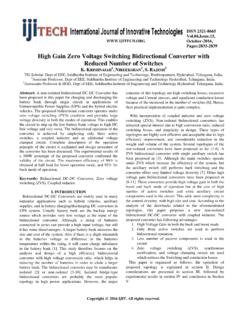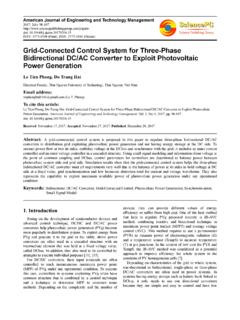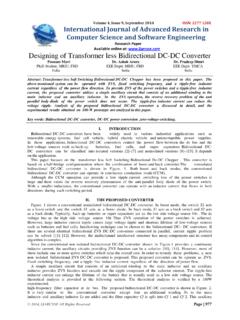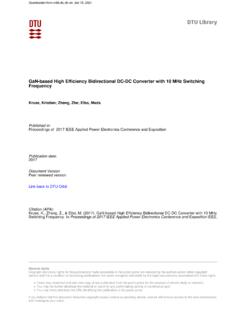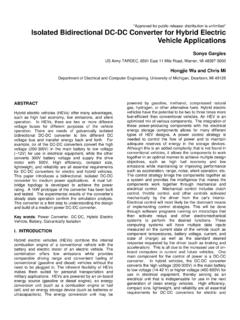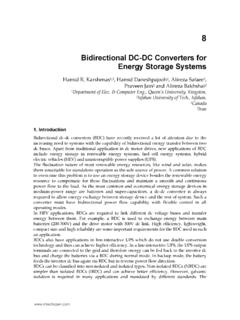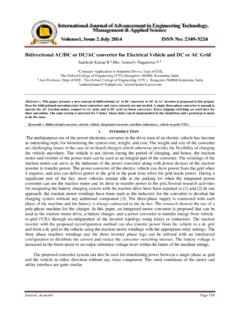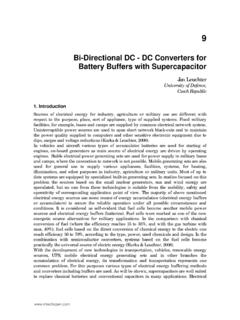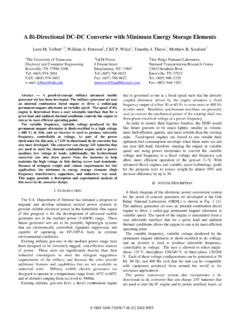Transcription of A Resounding Converter Topology for Bidirectional DC-DC ...
1 International Journal of Scientific Engineering and Applied Science (IJSEAS) - Volume-1, Issue-9, December 2015 ISSN: 2395-3470 123 A Resounding Converter Topology for Bidirectional DC-DC Converter Punit Kumar Chandra1, Tikeshwar Gajpal2 1 Raipur Institute of Technology, Raipur, India 2 Raipur Institute of Technology, Raipur, India Abstract Another Bidirectional DC DC Converter made out of two class-E Resounding converters is exhibited in this paper. Bidirectional converters are fundamental sorts of DC-DC Converter right now utilized as a part of the business today. Bidirectional DC-DC Converter may be segregated or non detached relying upon its application. Bidirectional DC-DC converters are being progressively used to accomplish force exchange between two dc force sources in either bearing without evolving extremity. It diminishes the expense and enhances the framework effectiveness, furthermore enhances the execution of the framework.
2 They are utilized as a part of numerous application, for example, dc un-intruded on force supplies, aviation power frameworks, electric vehicles and battery chargers. The point of this task is to utilize class E full method in Bidirectional dc Converter . Bidirectional force stream is controlled by transistor control beat recurrence changes, with a steady break between the succeeding heartbeats as in semi thunderous converters. The support or buck mode Converter operation relies on upon the common connection between the control beats of the transistor sets which are found corner to corner in the Converter scaffold. Because of the zero voltage exchanging of the transistor with high recurrence, this Converter Topology have essential components like low size, low weight. Simulation of existing Converter with full scaffold circuit furthermore, changed half extension circuit is done utilizing MATLAB.
3 Keywords: Bidirectional DC-DC Converter , Class E resonant Converter 1. Introduction DC-DC power converters are utilized in an assortment of utilizations, counting force supplies for PCs, office types of gear, rocket power frameworks, smart phones, supplies, power device vehicles, renewable vitality frameworks and so forth. In electric vehicle applications, an assistant vitality stockpiling battery retains the recovered vitality sustained back by the electric machine. Bidirectional DC-DC Converter is required to draw power from the assistant battery to support the high-voltage transport amid vehicle beginning, speeding up and slope climbing. With its capacity to switch the bearing of the present stream, and along these lines control, the Bidirectional DC-DC converters are as a rule progressively used to accomplish power exchange between two dc force sources in either bearing.
4 The greater part of the current Bidirectional DC-DC converters fall into the bland circuit structure outlined in on the situation of the helper vitality stockpiling, the Bidirectional DC-DC Converter can be sorted into buck and support sort. To understand the twofold sided force stream in Bidirectional DC-DC converters, the switch cell ought to convey the current on both headings. It is generally executed with a unidirectional semiconductor force switch, for example, power MOSFET (Metal-Oxide-Semiconductor-Field-Impact Transistor) or IGBT (Protected Door Bipolar Transistor) in parallel with a diode; on the grounds that the two-fold sided current stream force switch is not accessible. Writing gives numerous arrangements here, the primary of which can be ordered into a few trademark sorts.
5 The primary sort is, named as, a double dynamic extension (Spot) Converter [6]. The primary downside of this arrangement is that the Converter can't accomplish zero voltage exchanging (ZVS) in an extensive variety of burden varieties while data or yield voltage rises. To take out this issue in control framework, the stage movement was also improved with a beat width adjustment [7], [8]. A three-port dynamic scaffold (TAB) was presented as an augmentation of the Touch Topology [9]. Another kind of BDC is described by a present International Journal of Scientific Engineering and Applied Science (IJSEAS) - Volume-1, Issue-9, December 2015 ISSN: 2395-3470 124 bolstered inverter/rectifier on the low-voltage (LV) side of the transformer and a voltage-nourished inverter/rectifier on the high-voltage (HV) side. The disadvantage of this framework is the high voltage spikes incited by the transformer spillage inductance when the support Converter is exchanged transformer spillage inductance can be utilized as a valuable component as a part of the Resounding converters.
6 Utilizing high changing frequencies prompts a critical diminishment of size of detached parts. Semiconductor gadgets are presented to high di/dt amid replacements as a result of the vitality put away in their parasitic which expand exchanging misfortunes and electromagnetic impedance and may bring about breakdown of the gadget. Parasitic inductances and capacitances cause critical issues as the recurrence of the circuit is expanded. To address these issues in the configuration of high-recurrence working DC-DC converters topologies that consolidates these parasitic into circuit components are to be utilized. The class-E thunderous inverter Topology , addresses these issues which permit its operation in the request of megahertz frequencies with zero-voltage exchanging and zero-voltage incline at turn-on if the exchanging conditions are met.
7 The class-E Topology additionally assimilates the power MOSFETs parasitic capacitors into the circuit components and can be actualized with couple of parts. These qualities of class E Converter permit accomplishing high power densities, high productivity and it will bring about diminishment in the size and weight of the Converter . Fig. 1 Illustration of Bidirectional Power Flow Since class-E inverter can operate at very high frequencies, it can be used in designing resonant DC-DC converters. 2. Class E Inverter A Class E inverter is an understood Resounding Converter that can work at frequencies from several kHz to many MHz and force levels from watts to kilowatts with high effectiveness. Its fundamental circuit is appeared in Fig. 2. It comprises of a gag inductor L1, a shunt capacitor C1, an arrangement thunderous circuit C1, L1, a heap resistor R, and a transistor Tr.
8 The shunt capacitance C1 incorporates the yield transistor capacitance. The transistor Tr is typically exchanged intermittently at a obligation cycle of The best possible decision of circuit parameters ensures the transistor Tr is exchanged on for ZVS (zero-voltage exchanging) and ZdVS (zero-voltage slant exchanging) conditions that decide the ideal operation of Class E inverter. Fig. 2 Class E inverter A Class E inverter is a surely understood thunderous Converter that can work at frequencies from many kHz to several MHz and force levels from watts to kilowatts with high proficiency. Its fundamental circuit is appeared in Fig. 2. It comprises of a gag inductor L1, a shunt capacitor C1, an arrangement Resounding circuit C1, L1, a heap resistor R, and a transistor Tr. The shunt capacitance C1 incorporates the yield transistor capacitance.
9 The transistor Tr is generally exchanged occasionally at a obligation cycle of The best possible decision of circuit parameters ensures the transistor Tr is exchanged on for ZVS (zero-voltage exchanging) and ZdVS (zero-voltage slant exchanging) conditions that decide the ideal operation of Class E inverter. The voltage and current waveforms of standardized to the dc supply voltage U and the normal worth I of the supply current i, separately, and the time hub is standardized to the exchanging period T. Amid the International Journal of Scientific Engineering and Applied Science (IJSEAS) - Volume-1, Issue-9, December 2015 ISSN: 2395-3470 125 off interim of the transistor, the present iT stays at zero while the voltage uT increments to a greatest of times the dc voltage U. Toward the end of the off interim, when the voltage uT has diminished to zero, the transistor is exchanged on and the present iT increments toward a most extreme of times the dc current I.
10 Toward the end of the on-interim, the transistor is exchanged off and the present iT drops to zero preceding the voltage uT starts to rise. Amid exchanging moves, both transistor voltage and current have zero hybrid qualities and, as an outcome, the main force misfortunes remaining are the conduction misfortunes. Efficiencies of Class E inverters can essentially surpass 90 rate. Expanded proficiency means lower data power, as well as less warmth scattering in the transistor. Fig. 3 Class E inverter waveform 3. Class E Resonant Bridge Bidirectional Converter The class-E Resounding extension BDC is appeared in Fig. 4. It comprises of two scaffold inverters sustained by current sources because of the information inductances LFL and. LFH. Inverter yields are associated by a transformer, which is portrayed by auxiliary to-essential turns proportion kT.
